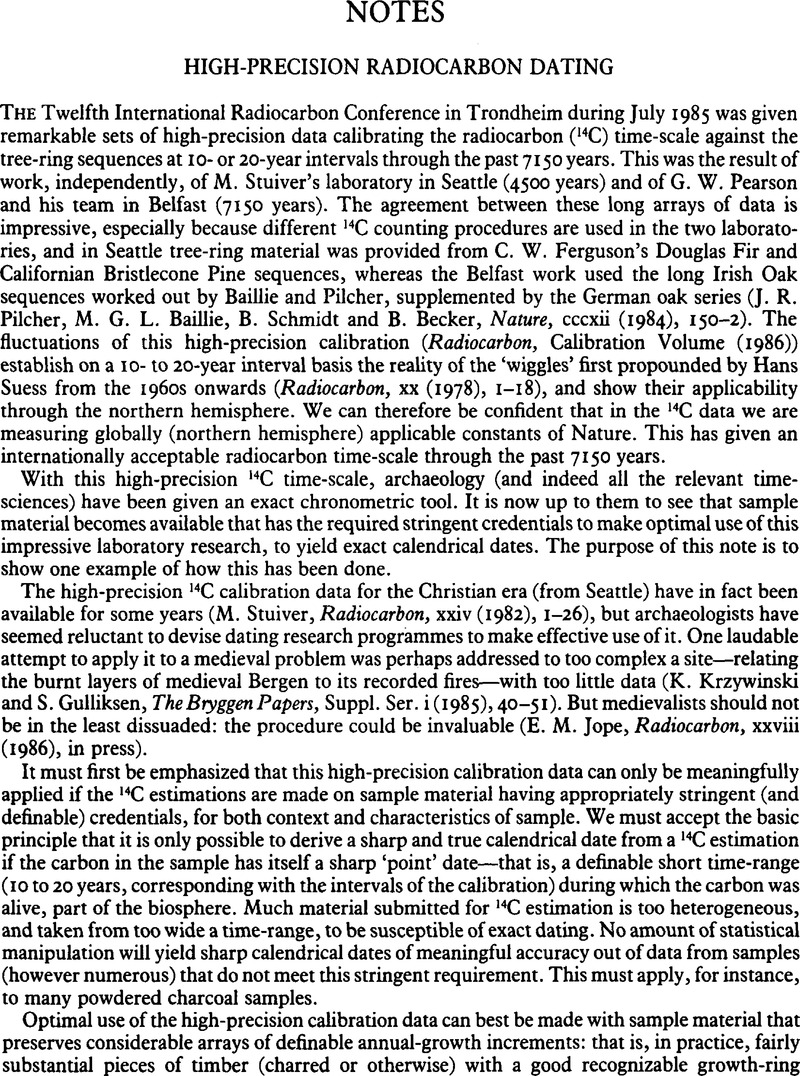No CrossRef data available.
Article contents
Cupid or Adonis? A New Roman Relief Carving from Lincoln
Published online by Cambridge University Press: 20 September 2011
Abstract

- Type
- Notes
- Information
- Copyright
- Copyright © The Society of Antiquaries of London 1986
References
Notes
1 Ambrose, T. and Henig, M., ‘A new Roman rider-relief from Stragglethorpe, Lincolnshire’, Britannia, xi (1980), 135–8CrossRefGoogle Scholar; Blagg, T. F. C., ‘A Roman relief-carving of three female figures, found at Lincoln’, Antiq. J. lxii (1982), 125–6CrossRefGoogle Scholar. See also Henig, M., ‘Graeco-Roman art and Romano-British imagination’, J.B.A.A. cxxxviii (1985), 1–22Google Scholar, fora general discussion of originality in both style and content in Romano-British art.
2 Archaeology in Lincolnshire 1984-1985 (First Annual Report of the Trust for Lincolnshire Archaeology, 1985), 44–6 and 49-50Google Scholar; we are grateful to M. J. Jones, F.S.A., Director (City of Lincoln), Trust for Lincolnshire Archaeology, for inviting us to exhibit the carving at a Ballot of the Society and for permission to publish it here.
3 R.I.B. 255, 256, 257, 262, 268.
4 cf. the gesture of Venus towards Mars on a wallpainting in Naples: Stuveras, R., Le Putto dans I'art romain, Coll. Latomus, xcix (Brussels, 1968), 200 and pl. LXXIV, aGoogle Scholar.
5 We are grateful to Dr J. P. Wild, F.S.A., for his comments on the costume; cf. p. 405 in his ‘The clothing of Britannia, Gallia Belgica and Germania Inferior’, Aufstieg und Niedergang der'römischen Welt, ii.12.3 (1985), 362–422Google Scholar.
6 The headgear is not like the close-fitting bonnet worn by some Treveran women, for example: Wild, J. P., ‘Clothing in the north-western provinces of the Roman Empire’, Banner Jahrb. clxviii (1968), 166–240, pp. 198-9 and fig. 20Google Scholar.
7 Toynbee, J. M. C., Art in Britain under the Romans (Oxford, 1964), 171–4Google Scholar.
8 Apuleius, , Metamorphoses, iv.28-vi.24Google Scholar.
9 Calza, R. and Nash, E., Ostia (Florence, 1959), fig. 44Google Scholar. There is part of the torso of a similar group from Woodchester: Clarke, G., ‘The Roman villa at Woodchester’, Britannia, xiii (1982), 197–228CrossRefGoogle Scholar.
10 e.g. Ferri, S., Arte romana sul Danubio (Milan, 1933)) 235 and 245, fig. 298Google Scholar; Reinach, S., Repertoire des reliefs grecs et romains (Paris, 1912), ii, 471, and iii, 294–5Google Scholar.
11 Lexicon Iconographicum Mythologiae Classicae, ii (Zurich and Munich, 1984), nos. 1241, 1242, 1244, 1245Google Scholar.
12 For the sources, see Lehmann, P. W., Roman Wall-Paintings from Boscoreale in the Metropolitan Museum of Art (Cambridge, Mass., 1953), 46, nn. 68 and 69Google Scholar.
13 Ibid., 38-49 and pls. IV and v.
14 Lexicon Iconographicum Mythologiae Classicae, i (Zurich and Munich, 1981), 224-5, nos. 12 15 19aGoogle Scholar.
15 Robert, C., Die antiken Sarkophag-Reliefs, iii. 1: Einzelmythen (Rome, 1969), Tafn. nno. 9, 111 no. 12 and v no. 20Google Scholar. See also Lehmann, , op. cit. (note 12), 43–5Google Scholar. They are represented in a similar pose on the pediment of a funerary monument from Flavia Solva in Noricum: Toynbee, J. M. C., ‘Greek myth in Roman stone’, Latomus, xxxvi (1977), 343–412, p. 352Google Scholar; illustrated in Ferri, , op. cit. (note 10), 114, fig. 101Google Scholar.
16 Lehmann, , op. cit. (note 12), 47 and 125–8Google Scholar, for discussion and references to the ancient sources and modern literature on the subject.
17 , Furtwangler-Reichhold, Griechische Vasen-malerei, ii (Munich, 1909), 98–9 and pl. LXXVIIIGoogle Scholar; Lehmann, , op. cit. (note 12), 126–7 and fig. 67Google Scholar.
18 Adonis might appear as a slim youth or, in Roman representations, as a ‘strapping, fully-developed if beardless figure’: Lehmann, , op. cit. (note 12), 39Google Scholar; cf. Ovid, , Metamorphoses, x.522-3Google Scholar: ‘nuper erat genitus, modo formosissimus infans, / iam iuvenis, iam vir, iam se formosior ipso est.’
19 Most of the representations of Greek myths discussed by Toynbee, (op. cit. in note 15) are on tombs and gravestonesGoogle Scholar. From Britain, note the fragmentary relief from Chester, showing the death of Adonis: Wright, R. P. and Richmond, I. A., Catalogue of the Roman Inscribed and Sculptured Stones in the Grosvenor Museum, Chester (Chester, 1955), no. 140Google Scholar.
20 We are grateful to Hugh Thompson, F.S.A., and Catherine Johns, F.S.A., respectively, for these observations. It was also noted, on exhibit at ballot, that the carving appeared to best effect at a distance of 20-30 ft. (6-9 m.). For the other Lincoln reliefs: Guide to the Antiquities of Roman Britain (British Museum, 1964), 55 and pl. xixGoogle Scholar; Blagg., T. F. C.op. cit. in note 1Google Scholar.
21 Examples from the Empire as a whole are too numerous to require citation. Among Romano-British wall-paintings, Cupid is figured in the baths of the villa at Southwell, Nottinghamshire, and, possibly with Venus, in a house at Kingscote, Gloucestershire: Davey, N. and Ling, R., WallPainting in Roman Britain, Britannia monograph 3 (London, 1982), 155–7 and 79, and 121Google Scholar. M.H. believes that the subject of this latter fresco might be Venus and Adonis with Cupid as an intermediary.
22 Varro, , De re rustica, i.i.6Google Scholar.
23 Sandars, N. K., Prehistoric Art in Europe (Harmondsworth, 1968), 275–84Google Scholar.
24 Henig, , op. cit. in note 1Google Scholar.




